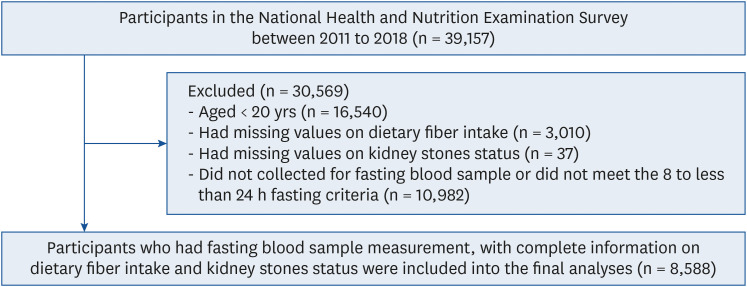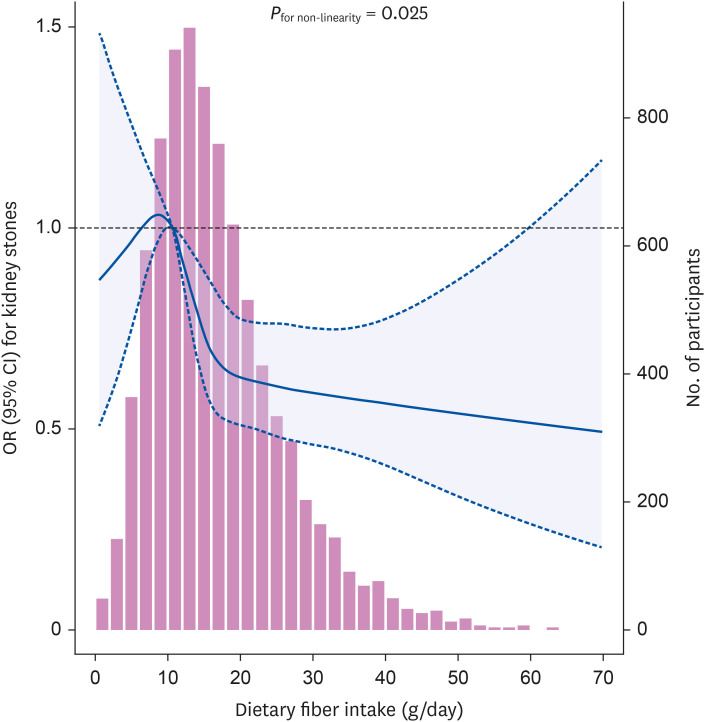Nutr Res Pract.
2024 Aug;18(4):534-543. 10.4162/nrp.2024.18.4.534.
Association between dietary fiber intake and kidney stones: results from the National Health and Nutrition Examination Survey (2011–2018)
- Affiliations
-
- 1Department of Urology, Peking University People’s Hospital, Beijing 100044, China
- 2Department of Epidemiology and Biostatistics, School of Public Health, Peking University, Beijing 100191, China
- KMID: 2558491
- DOI: http://doi.org/10.4162/nrp.2024.18.4.534
Abstract
- BACKGROUND/OBJECTIVES
Studies on the impact of dietary fiber intake on kidney stones are few, and their results were controversial. This study aimed to explore the association between dietary fiber intake and kidney stones in the nationally representative population of the USA.
SUBJECTS/METHODS
This cross-sectional research included 8,588 participants from the National Health and Nutrition Examination Survey, 2011 to 2018. Information regarding dietary fiber intake was obtained from a 24-h recall survey. Participants were categorized into different dietary fiber intake tertiles according to the average of 2 days of dietary recall data. The outcome was self-reported kidney stones. After adjusting for the traditional risk factors, a multivariate logistic regression model was used to examine the association between dietary fiber intake and kidney stones.
RESULTS
Eight hundred seventy-two participants had kidney stones. The weighted prevalence (SE) of kidney stones in the lowest tertile, medium tertile, and highest tertile of dietary fiber intake was 11.8% (0.8%), 10.3% (0.8%), and 9.1% (0.8%), respectively. After adjusting for age, sex, race and ethnicity, education level, smoking status, alcohol consumption, physical activity, body mass index, hypertension, diabetes, dyslipidemia, daily water intake, chronic kidney disease stage 3–5, and total energy intake, participants with the highest tertile of fiber intake had a significantly lower risk of kidney stones (odds ratio [OR], 0.68; 95% confidence interval [CI], 0.48–0.95) compared to those in the lowest tertile. Every 5 g/day increment in dietary fiber intake was associated with a significant decrease in risk of kidney stones (OR, 0.90; 95% CI, 0.83–0.98).
CONCLUSION
An increase in dietary fiber intake was associated with a lower risk of kidney stones, suggesting adults should be encouraged to maintain an adequate dietary fiber intake to prevent the development of kidney stones. Our results provide evidence to formulate nutrition management strategies for the prevention of kidney stones.
Keyword
Figure
Reference
-
1. Romero V, Akpinar H, Assimos DG. Kidney stones: a global picture of prevalence, incidence, and associated risk factors. Rev Urol. 2010; 12:e86–e96. PMID: 20811557.2. Khan SR, Pearle MS, Robertson WG, Gambaro G, Canales BK, Doizi S, Traxer O, Tiselius HG. Kidney stones. Nat Rev Dis Primers. 2016; 2:16008. PMID: 27188687.
Article3. Trinchieri A, Ostini F, Nespoli R, Rovera F, Montanari E, Zanetti G. A prospective study of recurrence rate and risk factors for recurrence after a first renal stone. J Urol. 1999; 162:27–30. PMID: 10379732.
Article4. Moe OW. Kidney stones: pathophysiology and medical management. Lancet. 2006; 367:333–344. PMID: 16443041.
Article5. Pearle MS, Calhoun EA, Curhan GC. Urologic Diseases of America Project. Urologic diseases in America project: urolithiasis. J Urol. 2005; 173:848–857. PMID: 15711292.6. Heers H, Turney BW. Trends in urological stone disease: a 5-year update of hospital episode statistics. BJU Int. 2016; 118:785–789. PMID: 27128735.
Article7. Barber TM, Kabisch S, Pfeiffer AFH, Weickert MO. The health benefits of dietary fibre. Nutrients. 2020; 12:3209. PMID: 33096647.
Article8. P NPV, Joye IJ. Dietary fibre from whole grains and their benefits on metabolic health. Nutrients. 2020; 12:3045. PMID: 33027944.
Article9. Evans CEL. Dietary fibre and cardiovascular health: a review of current evidence and policy. Proc Nutr Soc. 2020; 79:61–67. PMID: 31266545.
Article10. Weickert MO, Pfeiffer AF. Metabolic effects of dietary fiber consumption and prevention of diabetes. J Nutr. 2008; 138:439–442. PMID: 18287346.11. Anderson JW, Baird P, Davis RH Jr, Ferreri S, Knudtson M, Koraym A, Waters V, Williams CL. Health benefits of dietary fiber. Nutr Rev. 2009; 67:188–205. PMID: 19335713.
Article12. Gleeson MJ, Thompson AS, Mehta S, Griffith DP. Effect of unprocessed wheat bran on calciuria and oxaluria in patients with urolithiasis. Urology. 1990; 35:231–234. PMID: 2156368.
Article13. Jahnen A, Heynck H, Gertz B, Classen A, Hesse A. Dietary fibre: the effectiveness of a high bran intake in reducing renal calcium excretion. Urol Res. 1992; 20:3–6. PMID: 1310550.
Article14. Sorensen MD, Hsi RS, Chi T, Shara N, Wactawski-Wende J, Kahn AJ, Wang H, Hou L, Stoller ML. Women’s Health Initiative Writing Group. Dietary intake of fiber, fruit and vegetables decreases the risk of incident kidney stones in women: a Women’s Health Initiative report. J Urol. 2014; 192:1694–1699. PMID: 24859445.
Article15. Turney BW, Appleby PN, Reynard JM, Noble JG, Key TJ, Allen NE. Diet and risk of kidney stones in the Oxford cohort of the European Prospective Investigation into Cancer and Nutrition (EPIC). Eur J Epidemiol. 2014; 29:363–369. PMID: 24752465.16. Centers for Disease Control and Prevention. NHANES—history [Internet]. Atlanta (GA): Centers for Disease Control and Prevention;2022. cited 2024 May 12. Available from: https://www.cdc.gov/nchs/nhanes/history.htm.17. Centers for Disease Control and Prevention. NHANES—laboratory data [Internet]. Atlanta (GA): Centers for Disease Control and Prevention;2022. cited 2024 May 12. Available from: https://wwwn.cdc.gov/nchs/nhanes/search/datapage.aspx?Component=Laboratory.18. Centers for Disease Control and Prevention. National Health and Nutrition Examination Survey, 2011–2012 data documentation, codebook, and frequencies, kidney conditions - urology (KIQ_U_G). Atlanta (GA): Centers for Disease Control and Prevention;2014. cited 2024 May 12. Available from: https://wwwn.cdc.gov/Nchs/Nhanes/2011-2012/KIQ_U_G.htm.19. World Health Organization. Obesity: Preventing and Managing the Global Epidemic. Report on a WHO Consultation on Obesity. Geneva: World Health Organization;2000.20. Levey AS, Stevens LA, Schmid CH, Zhang YL, Castro AF 3rd, Feldman HI, Kusek JW, Eggers P, Van Lente F, Greene T, et al. A new equation to estimate glomerular filtration rate. Ann Intern Med. 2009; 150:604–612. PMID: 19414839.
Article21. National Kidney Foundation. K/DOQI clinical practice guidelines for chronic kidney disease: evaluation, classification, and stratification. Am J Kidney Dis. 2002; 39:S1–S266. PMID: 11904577.22. American Heart Association. Whole grains, refined gains, and dietary fiber [Internet]. Dallas (TX): American Heart Association;2021. cited 2024 May 12. Available from: https://www.heart.org/en/healthy-living/healthy-eating/eat-smart/nutrition-basics/whole-grains-refined-grains-and-dietary-fiber.23. Littlejohns TJ, Neal NL, Bradbury KE, Heers H, Allen NE, Turney BW. Fluid intake and dietary factors and the risk of incident kidney stones in UK biobank: a population-based prospective cohort study. Eur Urol Focus. 2020; 6:752–761. PMID: 31085062.
Article24. Siener R, Heynck H, Hesse A. Calcium-binding capacities of different brans under simulated gastrointestinal pH conditions. In vitro study with (45)Ca. J Agric Food Chem. 2001; 49:4397–4401. PMID: 11559145.
Article25. Escribano J, Balaguer A, Roqué i Figuls M, Feliu A, Ferre N. Dietary interventions for preventing complications in idiopathic hypercalciuria. Cochrane Database Syst Rev. 2014; 2014:CD006022. PMID: 24519664.
Article26. Torre M, Rodriguez AR, Saura-Calixto F. Effects of dietary fiber and phytic acid on mineral availability. Crit Rev Food Sci Nutr. 1991; 30:1–22. PMID: 1657026.
- Full Text Links
- Actions
-
Cited
- CITED
-
- Close
- Share
- Similar articles
-
- Development of a Dietary Fiber Composition Table and Intakes of Dietary Fiber in Korea National Health and Nutrition Examination Survey (KNHANES)
- Analysis of the Relationship between Dietary Fiber Intake & Food Habits in the Korean Adult Population: Using the 2001 Korean National Health and Nutrition Survey Data and the Newly Established Dietary Fiber Database
- Effect of Physical Activity on the Association Between Dietary Fiber and Constipation: Evidence From the National Health and Nutrition Examination Survey 2005-2010
- Analysis of Dietary Fiber Intake in the Korean Adult Population Using 2001 Korean National Health and Nutrition Survey Data and Newly Established Dietary Fiber Database
- Association of Household Food Security with Dietary Intake: Based on the Third (2005) Korea National Health and Nutrition Examination Survey (KNHANES III)



